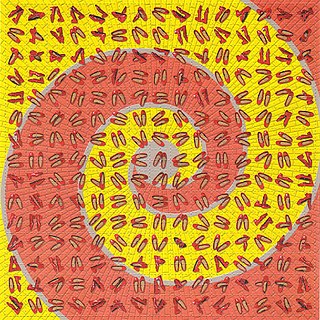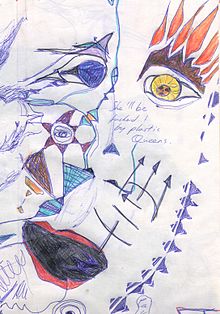
Lysergic acid diethylamide, commonly known as LSD, and known colloquially as acid or lucy is a potent psychedelic drug. Effects typically include intensified thoughts, emotions, and sensory perception. At sufficiently high dosages LSD manifests primarily mental, visual, and auditory hallucinations. Dilated pupils, increased blood pressure, and increased body temperature are typical. Effects typically begin within half an hour and can last for up to 20 hours. LSD is also capable of causing mystical experiences and ego dissolution. It is used mainly as a recreational drug or for spiritual reasons. LSD is both the prototypical psychedelic and one of the "classical" psychedelics, being the psychedelic with the greatest scientific and cultural significance. LSD is synthesized as a solid compound, typically in the form of a powder or a crystalline material. This solid LSD is then dissolved in a liquid solvent, such as ethanol or distilled water, to create a solution. The liquid serves as a carrier for the LSD, allowing for accurate dosage and administration onto small pieces of blotter paper called tabs. LSD is typically either swallowed or held under the tongue. In pure form, LSD is clear or white in color, has no smell, and is crystalline. It breaks down with exposure to ultraviolet light.

Psychedelia usually refers to a style or aesthetic that is resembled in the psychedelic subculture of the 1960s and the psychedelic experience produced by certain psychoactive substances. This includes psychedelic art, psychedelic music and style of dress during that era. This was primarily generated by people who used psychedelic drugs such as LSD, mescaline and psilocybin and also non-users who were participants and aficionados of this subculture. Psychedelic art and music typically recreate or reflect the experience of altered consciousness. Psychedelic art uses highly distorted, surreal visuals, bright colors and full spectrums and animation to evoke, convey, or enhance the psychedelic experience. Psychedelic music uses distorted electric guitar, Indian music elements such as the sitar, tabla, electronic effects, sound effects and reverb, and elaborate studio effects, such as playing tapes backwards or panning the music from one side to another.

Stanislav "Stan" Grof is a Czech-born psychiatrist who has been living in the United States since the 1960s. Grof is one of the principal developers of transpersonal psychology and research into the use of non-ordinary states of consciousness for purposes of psychological healing, deep self-exploration, and obtaining growth and insights into the human psyche. In 1993, Grof received an Honorary Award from the Association for Transpersonal Psychology (ATP) for major contributions to and development of the field of transpersonal psychology, given at the occasion of the 25th Anniversary Convocation held in Asilomar, California. He also received the VISION 97 award granted by the Foundation of Dagmar and Václav Havel in Prague on October 5, 2007. In 2010, he received the Thomas R. Verny Award from the Association for Pre- and Perinatal Psychology and Health (APPPAH). On the other hand, Grof has been criticized by the skeptic group Český klub skeptiků Sisyfos in the Czech Republic for furthering what they view as nonscientific psychology too far outside the bounds of the materialistic philosophical underpinnings of modern science. He is the only person to have been awarded the anti-prize Erratic Boulder Award twice in that country. Grof was married to psychologist Brigitte Grof in 2016.

The psychedelic drug lysergic acid diethylamide (LSD) was first synthesized on November 16, 1938, by the Swiss chemist Albert Hofmann in the Sandoz laboratories in Basel, Switzerland. It was not until five years later on April 19, 1943, that the psychedelic properties were found.

Psychedelic art is art, graphics or visual displays related to or inspired by psychedelic experiences and hallucinations known to follow the ingestion of psychedelic drugs such as LSD, psilocybin, and DMT. The word "psychedelic" means "mind manifesting". By that definition, all artistic efforts to depict the inner world of the psyche may be considered "psychedelic".
A psychedelic experience is a temporary altered state of consciousness induced by the consumption of a psychedelic substance. For example, an acid trip is a psychedelic experience brought on by the use of LSD, while a mushroom trip is a psychedelic experience brought on by the use of psilocybin. Psychedelic experiences feature alterations in normal perception such as visual distortions and a subjective loss of self-identity, sometimes interpreted as mystical experiences. Psychedelic experiences lack predictability, as they can range from being highly pleasurable to frightening. The outcome of a psychedelic experience is heavily influenced by the person's mood, personality, expectations, and environment.
Dean Chamberlain is a photographer who specializes in unique lighting effects and extended exposure times. Famous models for his pictures sit for up to five hours as he leaves the camera shutter open and "paints" the space around them with carried and projected lights of various colors and shapes, creating luminous and colorful images. His technique was described by one of his exhibitions as "Painting With Light Through Time and Space."

Richard Elliot Doblin is an American drug activist and executive who is the founder and former executive director of the Multidisciplinary Association for Psychedelic Studies (MAPS).
Dr. Athanassios Kafkalides was a Greek neuropsychiatrist. He was born in 1919 and he died in 1989 while in Athens. He graduated in medicine from the University of Athens and took post-graduate courses in neurology, experimental neurophysiology, neurosurgery and psychiatry at the Prince of Wales General Hospital, the Institute of Neurology in London, the Serafimer Lazarettet and the Karolinska Institutet in Stockholm, and the Eginition Hospital in Athens. From 1960 to 1987 he devoted a great deal of time to clinical research into the field of psychedelic psychotherapy, using drugs such as LSD, psilocybin and ketamine. At the IV World Congress of Psychiatry in Madrid, in 1966, he delivered a paper on the subject of intrauterine life, pioneering the field of pre- and perinatal psychology. He delivered further papers on intrauterine experiences and their repercussions at the VI International Congress of Psychotherapy, the Panhellenic Congress of Psychiatry in Salonica (1972), Athens, and at the Congress of Preventive Psychiatry.

Oscar Janiger was an experimental psychiatrist and a University of California Irvine psychiatrist and psychotherapist, best known for his LSD research, which lasted from 1954 to 1962.

Hallucinogen persisting perception disorder (HPPD) is a non-psychotic disorder in which a person experiences apparent lasting or persistent visual hallucinations or perceptual distortions after a previous use of drugs, including but not limited to psychedelics, dissociatives, entactogens, tetrahydrocannabinol (THC), and SSRIs. Despite being designated as a hallucinogen-specific disorder, the specific contributory role of psychedelic drugs is unknown.

Methylergometrine, also known as methylergonovine and sold under the brand name Methergine, is a medication of the ergoline and lysergamide groups which is used as an oxytocic in obstetrics and in the treatment of migraine. It reportedly produces psychedelic effects similar to those of lysergic acid diethylamide (LSD) at high doses.
Ego death is a "complete loss of subjective self-identity". The term is used in various intertwined contexts, with related meanings. Jungian psychology uses the synonymous term psychic death, referring to a fundamental transformation of the psyche. In death and rebirth mythology, ego death is a phase of self-surrender and transition, as described by Joseph Campbell in his research on the mythology of the Hero's Journey. It is a recurrent theme in world mythology and is also used as a metaphor in some strands of contemporary western thinking.
Walter Norman Pahnke was a minister, physician, and psychiatrist most famous for the "Good Friday Experiment", also referred to as the Marsh Chapel Experiment or the "Miracle of Marsh Chapel".

League for Spiritual Discovery (LSD) was a spiritual organization inspired by the works of Timothy Leary, and strove for legal use of lysergic acid diethylamide (LSD) for the purpose of meditation, insight, and spiritual understanding. It was in existence during the mid-to-late 1960s, and eventually closed by Leary. The New York Center for the League of Spiritual Discovery, in existence for around a year, was co-founded by Timothy Leary and Nina Graboi in 1966. The center was the first LSD-based meditation center in Manhattan.
Betty Grover Eisner was an American psychologist known for pioneering the use of LSD and other psychedelic drugs as adjuncts to psychotherapy.

Albert Hofmann was a Swiss chemist known for being the first to synthesize, ingest, and learn of the psychedelic effects of lysergic acid diethylamide (LSD). Hofmann's team also isolated, named and synthesized the principal psychedelic mushroom compounds psilocybin and psilocin. He authored more than 100 scientific articles and numerous books, including LSD: Mein Sorgenkind. In 2007, he shared first place with Tim Berners-Lee on a list of the 100 greatest living geniuses published by The Daily Telegraph newspaper.
The Spring Grove Experiment is a series of lysergic acid diethylamide (LSD) studies performed from 1963 to 1976 on patients with psychotic illnesses at the Spring Grove Clinic in Catonsville, Maryland. These patients were sponsored by a federal agency called the National Institute of Mental Health to be part of the first study conducted on the effects of psychedelic drugs on people with schizophrenia. The Spring Grove Experiments were adapted to study the effect of LSD and psychotherapy on patients including alcoholics, heroin addicts, neurotics, and terminally-ill cancer patients. The research done was largely conducted by the members of the Research Unit of Spring Grove State Hospital. Significant contributors to the experiments included Walter Pahnke, Albert Kurland, Sanford Unger, Richard Yensen, Stanislav Grof, William Richards, Francesco Di Leo, and Oliver Lee McCabe. Later, Spring Grove was rebuilt into the Maryland Psychiatric Research Center where studies continued to be performed for the advancement of psychiatric research. This study on LSD is the largest study on psychedelic drugs to date.
Ronald Arthur Sandison was a British psychiatrist and psychotherapist. Among his other work. he is particularly noted for his pioneering studies and use of lysergic acid diethylamide (LSD) as a psychotheraputic drug. As a consultant psychiatrist, his LSD work was mainly carried out during the 1950s and '60s at Powick Hospital, a large psychiatric facility near Malvern, Worcestershire, after which he spent several years in Southampton, where he was instrumental in the establishment of the university medical school. He returned to his native Shetland Isles in the 1970s and worked in psychotherapy there. He later specialised in psychosexual medicine on the UK mainland. Sandison died at the age of 94, and was buried in Ledbury near Malvern.

Blotter art is an art form printed on perforated sheets of absorbent blotting paper infused with liquid LSD. The delivery method gained popularity following the banning of the hallucinogen LSD in the late 1960s. The use of graphics on blotter sheets originated as an underground art form in the early 1970s, sometimes to help identify the dosage, maker, or batch of LSD.












